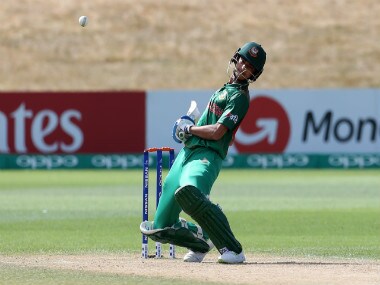The pink ball illuminated by floodlights was not the only thing of note in the recently concluded Indo-Bangladesh Test match. Two Bangladeshi players, Liton Das and Nayeem Hasan, retired hurt. The double-injury — both caused by Mohammed Shami bouncers — stole the limelight from the pink ball which was making its debut at a day/night Test in Kolkata’s famous Eden Garden. Das and Hasan ended up in the hospital with concussions, triggering the International Cricket Council’s (ICC’s) new Concussion Management Guidelines, which first came into play during the Ashes in August-September 2019. [caption id=“attachment_7712281” align=“alignleft” width=“380”]
 Representational image. Image source: Getty Images.[/caption] Here’s a look at the guidelines, and why cricketers badly needed a separate protocol to address this type of brain injury:
Representational image. Image source: Getty Images.[/caption] Here’s a look at the guidelines, and why cricketers badly needed a separate protocol to address this type of brain injury:
What is a concussion?
A concussion is a traumatic brain injury caused by a blow to the head. Violent whiplash or shaking of the head can also cause a concussion. The brain is encased by cerebrospinal fluid inside the skull. Sudden trauma causes the brain to strike the insides of the skull. Symptoms usually occur immediately; there is neurological impairment such as confusion, temporary amnesia, dizziness, slurred speech, headache or a feeling of pressure in the head. Loss of consciousness, seizures and ataxia are rare but can happen. In some cases, roughly 10% to 20%, symptoms may be delayed by a few hours or days after the incident so the person needs to be constantly monitored.
What do ICC guidelines recommend?
The ICC Concussion Management Guidelines follow the procedure laid down by the 2016 Berlin Concussion Consensus. A player diagnosed with or exhibiting signs of a concussion must be removed from the field and sent for further testing. They can be deemed fit for play only after authorized medical clearance. Only a “like for like” substitution is allowed: a player with a similar skill set can replace the injured player so that the outcome of the game is more faithfully matched to the structure of the original squad. For example, Nayeem Hasan, a bowler, was replaced by Taijul Islam, another bowler. Mehidy Hasan took over for Das, who is a keeper: this meant that Mehidy Hasan, a spinner could not bowl during the game.
How are on-field diagnoses made?
Team doctors or physios are called onto the field if a batsman is struck on the head. If the player has lost consciousness or a seizure, tonic posturing (sudden muscle stiffness), or amnesia is noted, a concussion is diagnosed right away. The medical staff ask the player how they are feeling. They also ask them a series of questions - called modified Maddock questions - to check for any cognitive impairment, memory loss or confusion. The questions can range from “Who is the bowler you were facing?” or “What is the target you are chasing?”, to review the mental state of the player. A video review can also be utilized, if available. Footage of the injury and the player’s state afterwards can indicate the condition that the player perhaps cannot.
What happens after the initial diagnosis is made?
If a concussion is suspected, the player is immediately taken off. If a concussion is not initially suspected, the player can resume play. However, he/she will continue to be monitored and checked for symptoms every four to five hours. At the close of play, the player will be taken to a medical facility to get scans using the SCAT 5 protocol. If a concussion is detected then they will not be a part of the rest of the game and be kept under observation. In this match, both Das and Hasan decided to play on after getting hit. Das walked out after seven more deliveries and Hasan went on to strike some fours before getting bowled. Both had delayed onset concussions and did not participate in the rest of the game.
A gradual return to the game
The ICC recommends a step-by-step or graded return, under the supervision of medical professionals. While there is no mandatory minimum time off, a week is considered standard. Typically, a graded return includes:
- 24 hours relative rest
- Light aerobic exercise
- Light training
- Full training
- Cleared to compete
If symptoms recur, the player needs to go back to light exercise. Should symptoms last more than three weeks, a complete neuropsychological assessment is required and MRI tests may be ordered to rule out structural brain damage. In 2014, Australian cricketer Philip Hughes died at a domestic Sheffield Shield game after an injury to the back of the neck. This sparked conversations on the need for a protocol. The two substitutions in the Indo-Bangladesh Test series last week were a result of the outcomes of these discussions. Health articles in Firstpost are written by myUpchar.com, India’s first and biggest resource for verified medical information. At myUpchar, researchers and journalists work with doctors to bring you information on all things health. For more information, please read our article on Head Injury _._
)